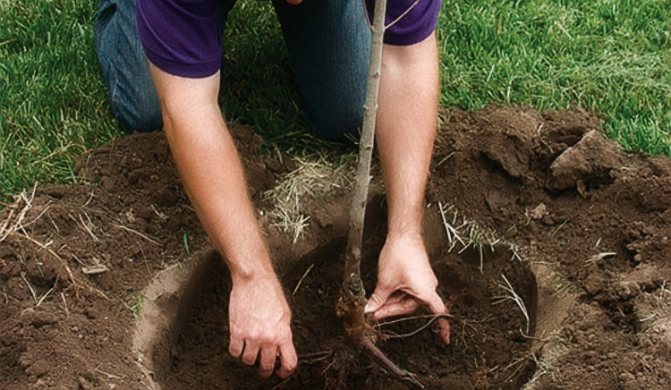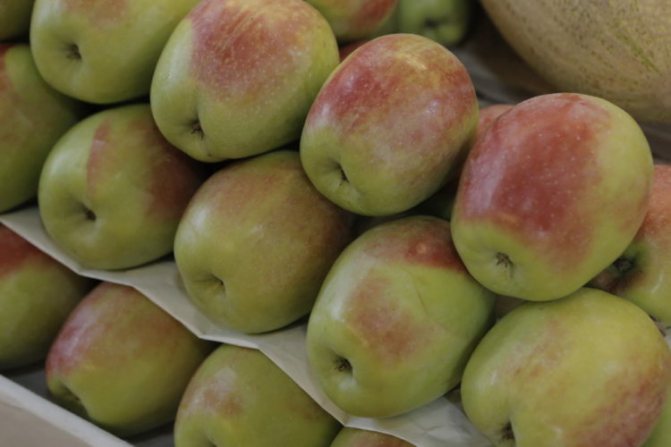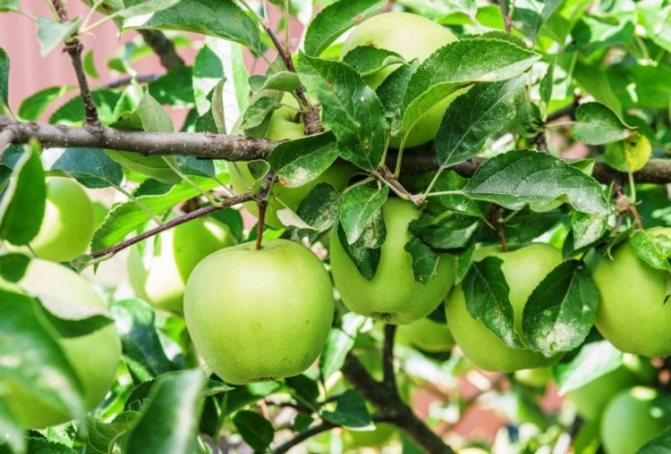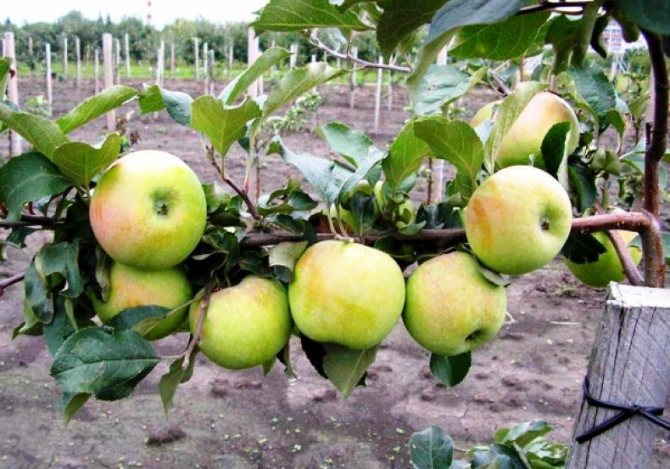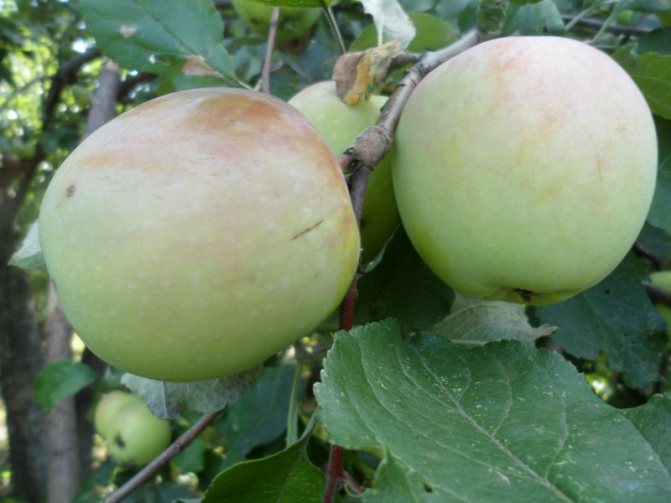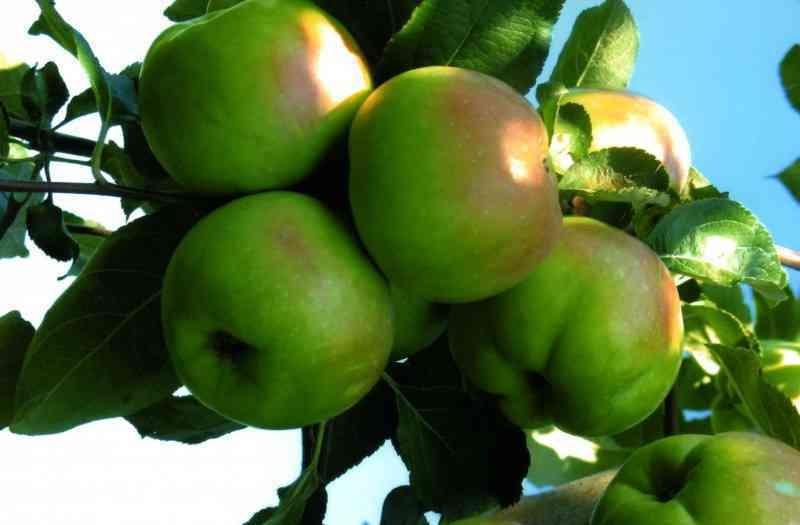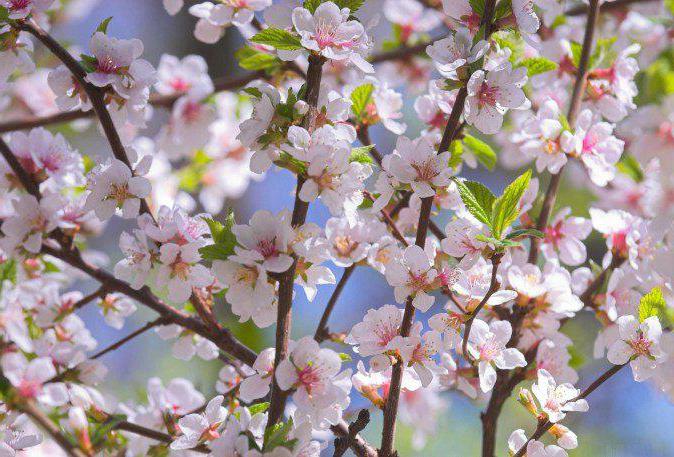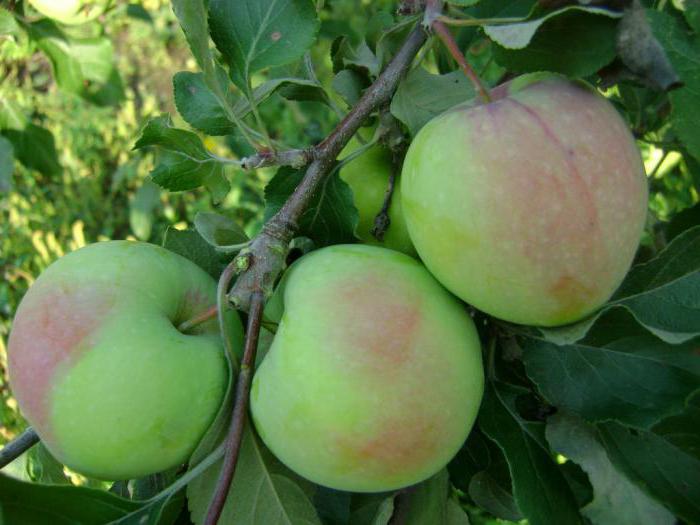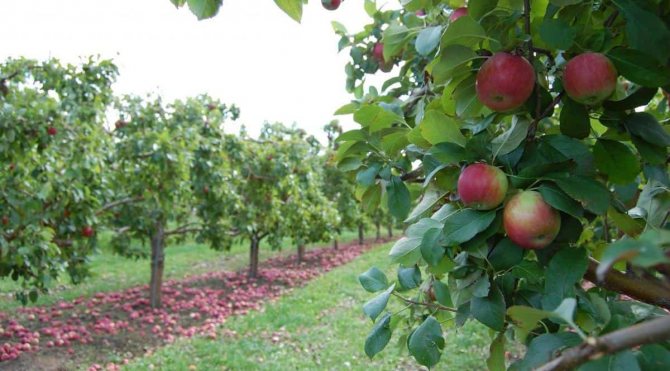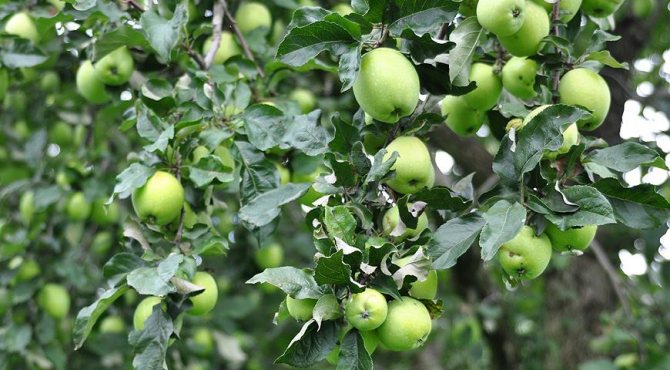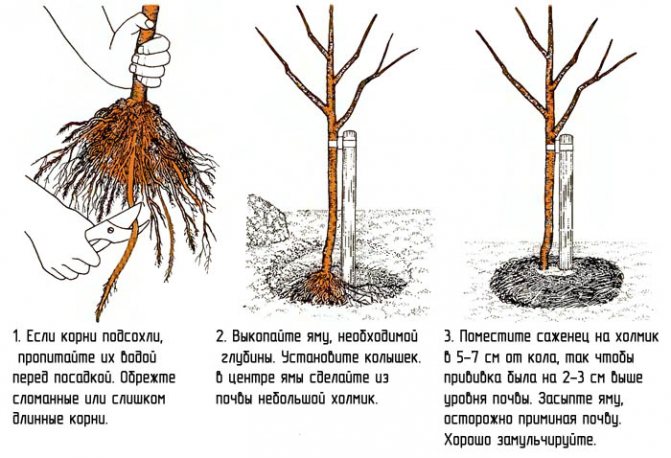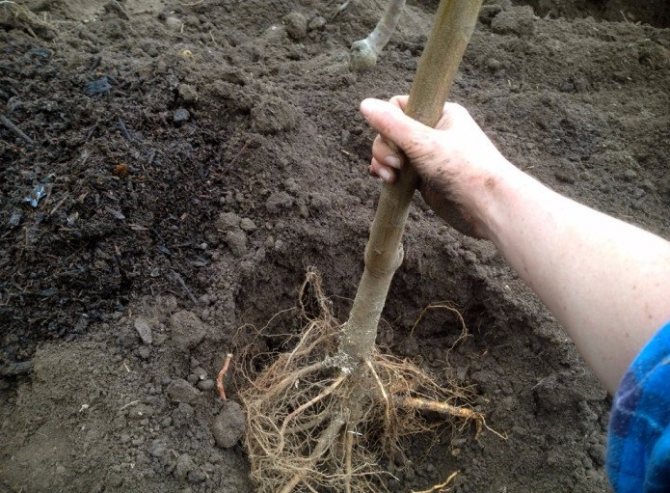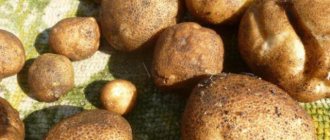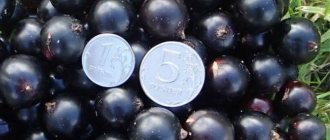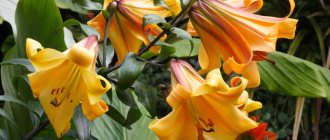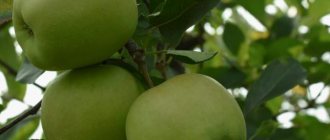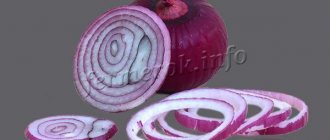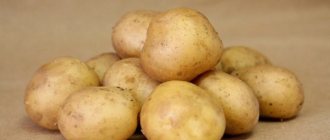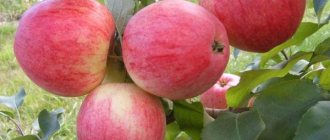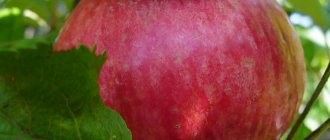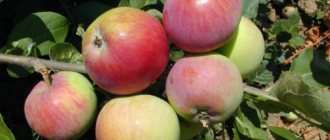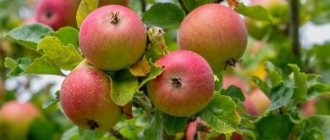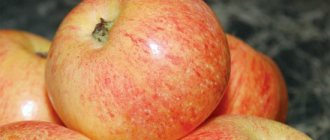»Gardening» Apple tree »Apple growing North Sinap
0
425
Article rating
Gardeners who live in colder areas try to find a variety that will be frost-tolerant. They focus on the best qualities that a tree and its fruits should have. The North Sinap apple tree is one of the best options. It is frost-resistant, has tasty, juicy fruits that can be stored for a long time.
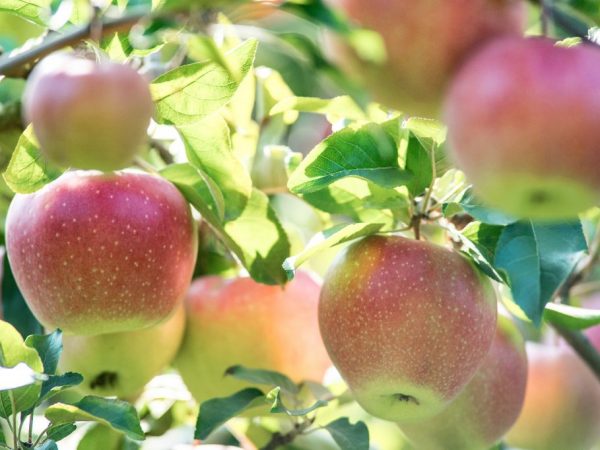
Apple Growing North Sinap
Apple tree North Sinap
This variety recommended for growing in regions with a moderately cold climate: Central Chernozem region, lower and middle Volga region. A special form of the tree - stale, can grow in Eastern Siberia.
Dignity varieties:
- Good keeping quality of fruits;
- Dessert taste of apples;
- High winter hardiness;
- Quick entry into fruiting.
Disadvantages:
- Large size of the tree on a full-grown scion;
- Fruits that are not uniform in size.
Advantages and disadvantages
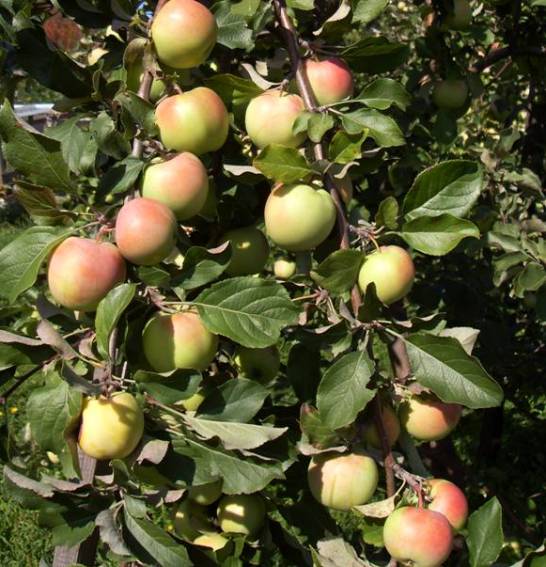

The Sinap apple tree has many advantages:
- The Sinap variety, with good care, gives a high-quality and bountiful harvest;
- The Sinap apple tree (except for the Crimean one) is winter hardiness;
- Apples are stored for 7-9 months and can be easily transported;
- any variety of Sinap variety is excellent and suitable for preparing a variety of dishes and preparations, as well as fresh consumption.
The disadvantages of the Sinap variety are:
- The trees are tall, making harvesting difficult;
- Late ripening of apples;
- a good harvest depends on a warm summer and the absence of autumn frosts in the fall (before harvest);
- with a large number of ovaries, the quality of the future crop deteriorates;
- in the absence of proper care, the yield drops, the apples become smaller, the taste becomes worse;
- unripe fruits have an unexpressed taste, are poorly stored;
- a certain time must pass before the apples are fully ripe;
- the variety has moderate resistance to drought, as well as to powdery mildew and scab;
- with a lack of nutrients in the soil, apples are affected by bitter pitting.
Characteristic
Wood
Vigorous, powerful, with a wide-pyramidal thin crown. The trunk and skeletal branches are gray-brown. The predominant part of the wood is perennial lateral branches from 3-5 skeletal branches.
Tree heightgrafted on a vigorous stock reaches 7 meters, and the width is 6-7 m in diameter. Semi-dwarf rootstocks form a more compact crown of the plant.
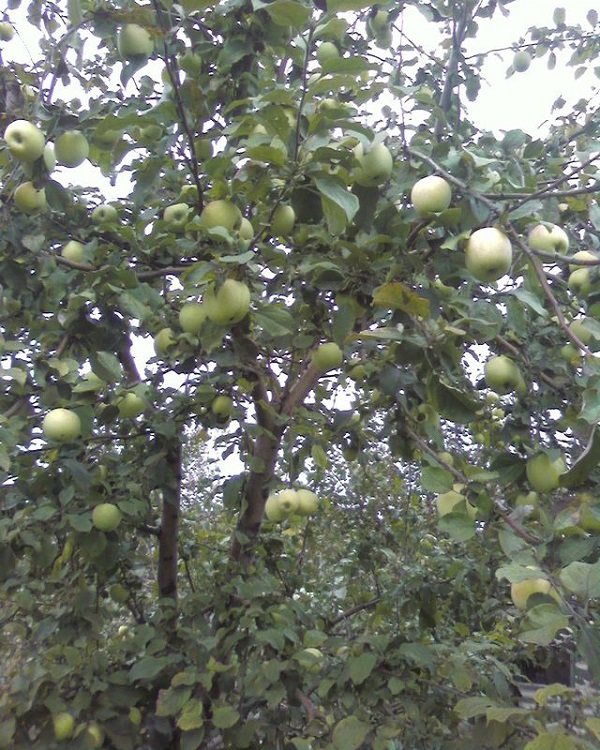

North synap on a vigorous rootstock.
Escapes
Straight, medium thickness with slight cranking, classic brown... The cuttings are small and few in number.
Leaves
Shiny, medium-sized, wide and heavily pubescent... Their color is dark green, with slightly grayish tint.
Flowers
Large, with red buds and pink petals.
Fruit and tasting score
Medium size (110-130 gr.), round-conical shape. The coat color of the apple is green, with a brownish-red blush. The subcutaneous points are light and numerous. The pulp is white with a light mint shade, juicy and sweet, with a pleasant sourness. It has a medium density and fine-grained structure.
The tasting score is quite high - 4.3-4.4 points.
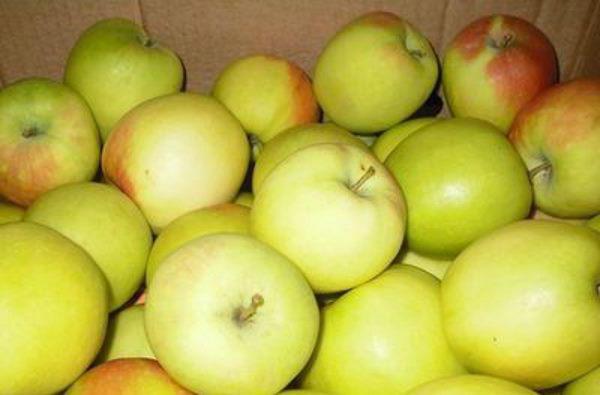

The fruits of the North Synap.
Watch the video for an overview of the fruits of the North Synap:
Yield
High, reaches 150 kg from an adult tree.
Winter hardiness
High (up to - 35 ° Ϲ), only slightly inferior to the Antonovka Ordinary.
Disease resistance
Average.
Self-fertility
This variety belongs to partially self-fertile varieties, but without cross-pollination with other apple trees, brings less than half of the possible harvest. To increase fertility, he needs apple pollinators, such as:
- Antonovka;
- Slav;
- Pepin Saffron.
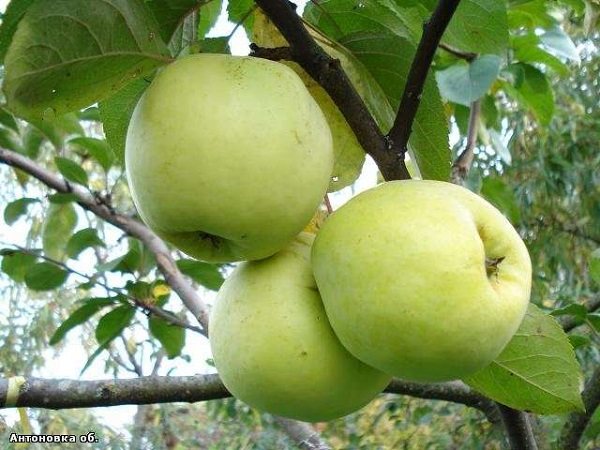

Antonovka.
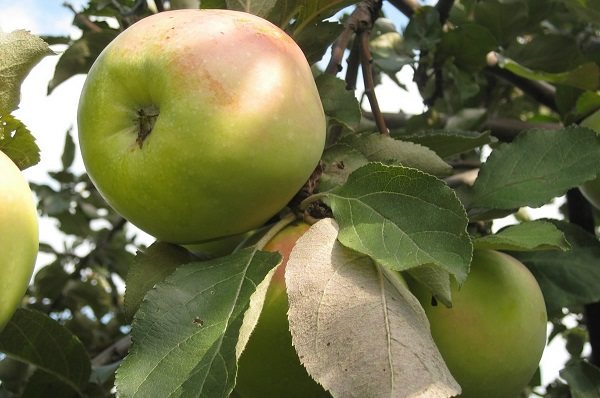

Slav.
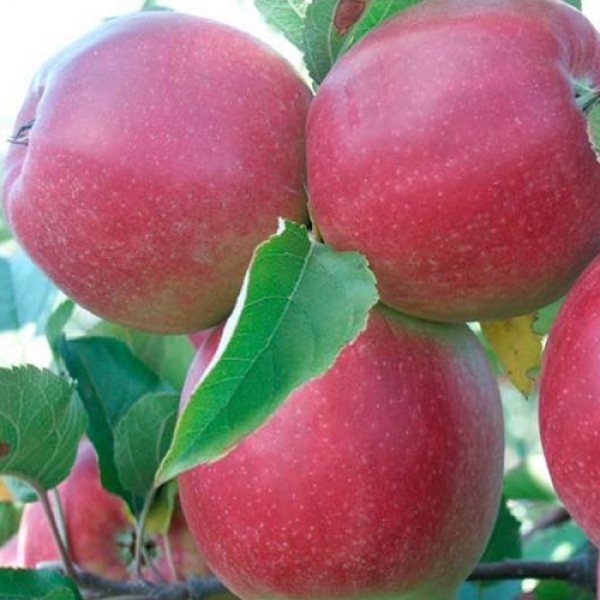

Pepin Saffron.
Advice! If you don't have room to plant a pollinator, you can graft a sprig of it onto an already growing apple tree.
Origin
The Sinap apple variety is a Ukrainian selection of apples and, moreover, one of the most common among all other apple varieties. It belongs to the category, the representatives of which are characterized by the autumn ripening period.
Little is known about the origin of the Sinap variety. There are several versions regarding this, but the most popular of them is as follows: this variety, which previously occupied about 8% of all Crimean apple orchards, arose as a result of an accidental mutation in the process of sowing seeds from a related category - Sary Sinap.


The huge popularity of this variety is evidenced by a lot of documented data. Thus, it is known that in 1907, in one of the Belbek gardens, a harvest of 300 poods was obtained from just four trees. At the same time, it seems absolutely incredible that all 100 poods of apples were removed from one tree, which is about 1600 kg. As you can see, the level of yield was really high, which is why the price for one pood fluctuated within 5-8 rubles. Here it should be emphasized that in those days it was possible to buy a good cow for this price.
Many mentions of the Sinap variety were found in the records of academician Peter Palass, who traveled a lot in Crimea, and gardener Lev Simirenko. So, the first found the sphere of fruit growing already fully developed in the Crimea of the 18th century, and gave the Sinap Kandil variety a special place among the others, which also have significant superiority in terms of abundance and quality.
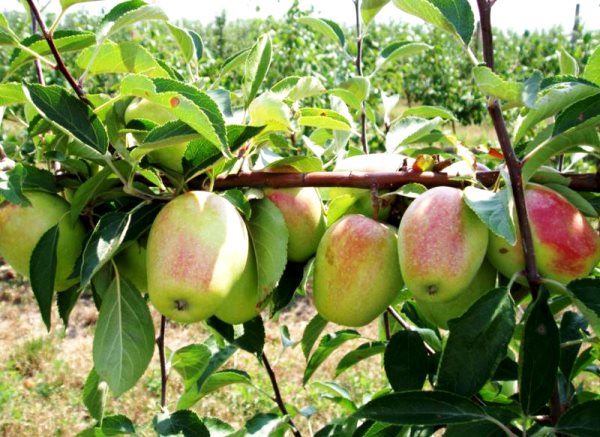

But such success, as in most similar cases, could not last forever. Therefore, soon Kandil was supplanted by American and European varieties, which turned out to be more productive. As a result, today the described variety can be rarely found on the territory of industrial plantings.
By the way, the word "kandil" is of Crimean Tatar origin and means "lamp". And the word "sinap", as one of the versions says, is a slightly distorted form of the name of one of the Turkish capes.
Testimonials
Sergey N., Ryazan. ‟North Sinup is already a classic of winter apple trees. I have 2 of these, I got it when I looked at the photo and description of the variety. But we eat our apples until next summer! The variety is unpretentious, but so that it does not cover other trees with its shadow, I prune it every year. "
Tamara L. T., Ivanovo. ‟I got this adult apple tree from the previous owners of the dacha. I don't know how old she is, but she bears fruit in a year. This did not suit me, and I cut off about a quarter of its branches. The apple tree revived and began to bear fruit every year. In general, it quickly regained its former size, building up half a meter of shoots in a year. "
Ivan Sergeevich N., Volgograd. ‟Sinap is certainly good, but morally outdated. Its main advantage is the long-term storage of apples, but otherwise it is an ordinary tree. I do not like the fact that the apples become smaller if there are a lot of them on the tree, and the fact that immediately after picking the apples are tasteless. To become pleasant, they need to lie down for at least 2 weeks. "
Gaul, Kazan. ‟I planted this apple tree 4 years ago.The tree took root well and grew quickly! On the advice of the seller, I chose a seedling on a low rootstock, and it bloomed for 2 years after planting. And the next year we collected 8 apples from it! ”
Description of the variety
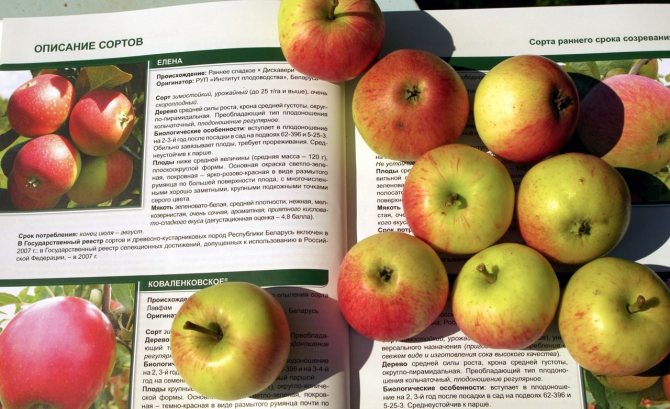

The North Sinap is a common variety that is often grown in our country, not only in gardens and vegetable gardens, but also in flower beds in parks. The culture has been popular for a long time, it has gained complete confidence in the high quality of the crop. And also it quickly adapts to any growing conditions.
With minimal effort, this variety gives a large number of fruits with high qualities that are stored for a long time (there are cases when the crop continued to be stored for several years), without losing its attractive appearance and taste.
The culture grows big and strong (the total height can be up to five meters). The shape is pyramidal, the crown is distinguished by a large green mass, includes thick spreading branches and thin lateral branches. The leaves are colored dark green with pubescence, elongated, strongly curly at the end.
The plant begins to bear fruit quite early. Already after several years after planting the plant, the first harvest begins to appear on it, and young trees begin to give a stable amount of fruits only after four years have passed from the moment of planting. With an apple tree about 15 years old, the gardener gets about 170 kilograms of apples, but with a high yield, the fruits from the trees begin to shrink and lose their taste.
Apple flowers are distinguished by their decorative effect. They are large, pale pink in color, bloom almost at the same time and look truly amazing. Also, northern varieties of apples are distinguished by their pleasant smell.
Landing
Timing
Young trees apple trees are planted in spring or autumn... Autumn planting (from mid-September to the beginning of persistent frosts) is considered more correct.
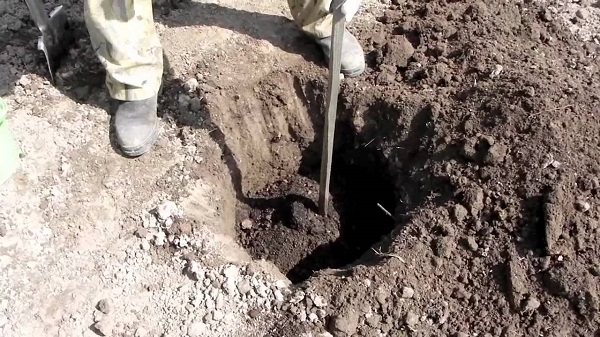

It is more correct to plant apple trees in the fall.
Planting a plant in the spring useful for seedlings grown in latitudes more southerly than the future growing area, and for trees under two years of age... It is produced on time from mid-April to mid-May.
Technology
For the tree choose well lit and spacious place, retreating from other trees 3.5-4 meters.
Attention! Apple trees don't like being near high groundwater! If your site is "flooded" during spring floods, plant trees in higher elevations.
5 steps to planting a tree correctly:
- Soak the roots of the tree for 5-10 hours in clean water;
- Prepare the landing pit. For planting a 2-3 year old apple tree, a depth and width of 60-70 cm is enough;
- Drive a strong peg into the bottom, at least 1.5 meters in length;
- Spread the roots of the seedling in the hole so that they look in different directions;
- Fill the hole with soil, and tie the tree trunk to a peg in 2 places.
Timing and choice of a place for planting an apple tree
An apple tree of the "Northern Sinap" variety will develop well when planting a seedling in a well-lit spacious area, where nothing will block its branches from accessing the sun.
Loose, breathable light soils will provide special comfort to the tree. Sandy loam and chernozems with neutral acidity are suitable. When choosing a site, it is important to consider the location of the groundwater. Ideally, they should be at a distance of 2–2.5 m, otherwise the roots will rot from an excess of moisture, and the tree will die.
When you have decided on the place and acquired high-quality planting material, which is of no small importance, you can start planting.
Some gardeners prefer spring rooting of seedlings, since such trees have time to adapt to winter, get stronger, and grow powerful roots and branches. In this case, it is recommended to plant in the last weeks of April and early May.It is important that the ground is not cold, therefore, taking into account the climatic characteristics of a particular region, wait until the ground is sufficiently warmed up. A relative disadvantage of spring dates is the need for constant moistening of the root system.
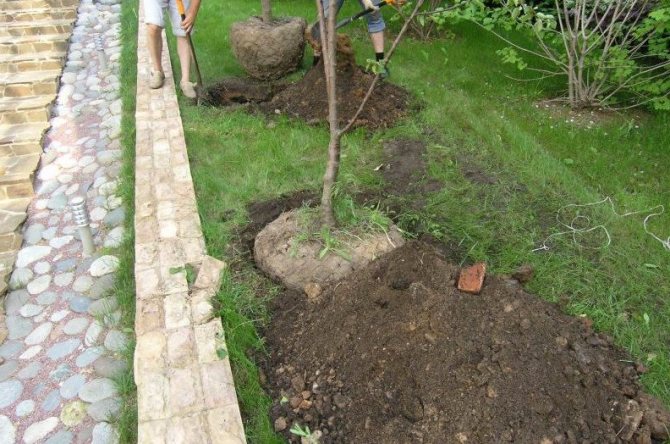

Other specialists prefer autumn plantings for winter-hardy varieties, emphasizing the ability of such seedlings to strengthen the roots, which is facilitated by moist autumn soil, and quickly get under way with the onset of heat. It is best to plan such rooting a few weeks before the start of the frost. The optimal dates are considered the beginning of October.
According to agronomists, young trees that are no more than 2 years old should be planted in the spring, and all other specimens, except for the old ones, in the fall. If it becomes necessary to transplant 10-year-old apple trees, it is better to plan planting for the winter, so as to injure the plant as little as possible.
Important! In no case should coniferous timber be used for mulching the tree trunks of apple trees. In the process of decomposition, they oxidize the soil, which is highly undesirable for fruit crops.
Cultivation and agricultural technology
Sinap apple variety does not require special agricultural technology and carebut, like any tree, it needs watering, pruning and protection from pests.
North Synap has medium drought tolerancewithout needing abundant watering. If you do not prune a mature tree, the fruit will become smaller and less juicy.
Pruning and shaping the crown
Crown formation necessary for young seedlings at the age of 2-7 years. With it, the length of the shoots is shortened, which allows the tree to grow in the form chosen by the gardener:
- Discharged-tiered;
- Cup-shaped;
- Vertical palmette.
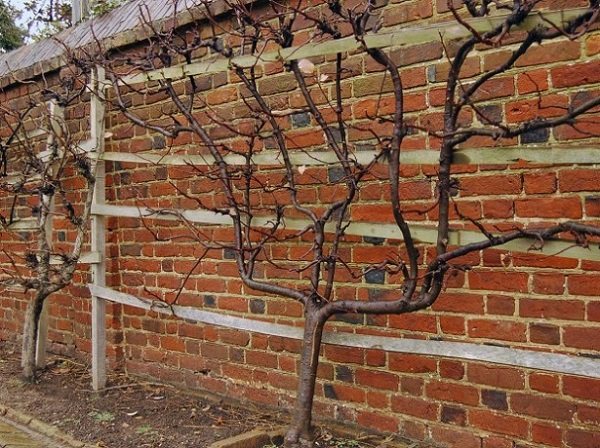

Vertical palmette.
Important! Pruning shoots makes the tree branch! If you do not do it, the tree will not be able to form the correct stem!
Tree pruning is needed for hygiene purposes and to remove excess green matter from mature apple trees. With hygienic pruning, branches thickening the crown, broken and diseased shoots are removed.
Protection against diseases and pests
All processing must be carried out at least 30-40 days before the start of the harvest. The apple tree is resistant to pest attacks. Moth, flower beetle and moth can settle on it. So that the tree does not suffer, it is enough to cut dry branches in time, whitewash the post and collect fallen apples.
In rainy weather, the apple tree can be affected by scab and powdery mildew. For prophylaxis before flowering, it is treated with "Topaz", and after collecting the fruits - with a solution of copper sulfate, in the fall they use Bordeaux liquid.
To get rid of the scab, during the blooming period, the apple tree is treated with "Skor", and after flowering - with "Hom".
Ripening and fruiting
Early maturity
The North Sinap apple tree is one of the intensive varieties that quickly bear fruit. A tall tree gives a yield of more than 3 kg, starting from 5-6 years of age.
Dwarf trees bloom in the second year after planting. With excessive nitrogen fertilization, the entry into fruiting is delayed, and the tree itself is actively increasing its green mass.
Timing
Maturation
The fruits of this variety reach removable ripeness during the period from the beginning of October to the middle. Apples hanging on a branch are not afraid of temperatures lowering to 0 ° Ϲ, and the more ripe the fruit is, the better its taste will become. Apples, harvested unripe, wither faster during storage and are more sour in taste.
For really good taste, North Sinap apples need a sum of active temperatures of at least 2500-2700 ° Ϲ.
Harvest storage
Harvested on time, fruits are stored until early June months. The optimum storage temperature for the crop is 0-4 ° Ϲ. At higher temperatures, the harvest lasts until March-April.
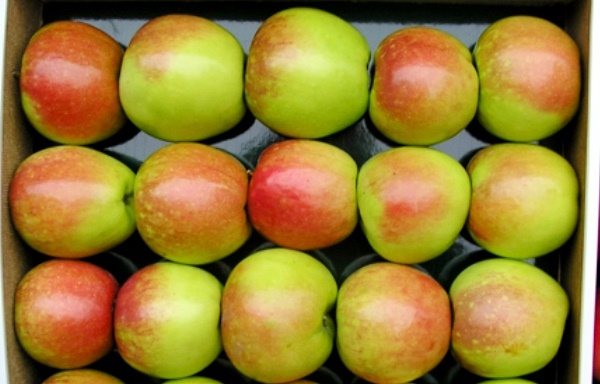

The fruits of the North Sinup, prepared for storage.
Care
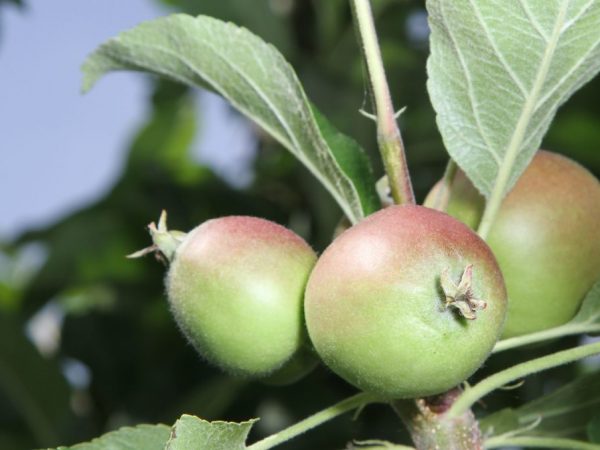

Watering and fertilizing will pay off
After planting the North Sinap apple tree, proper and timely care must be provided.
Watering
Watering is calculated depending on weather conditions, size and age of the tree. For a seedling, the initial water rate is 20-30 liters per 1 sq. m. Every year, up to 6 years, one bucket of water is added to the apple tree, and then 6 to 10 buckets of water go to one tree.
The first watering is carried out immediately after planting, as soon as the buds begin to bloom. If the apple tree grows in a warm area, the seedling is watered every week until the tree is 5 years old.
Then the procedure is carried out when the tree fades and the ovaries begin to form. Then moisten the root area before and after harvesting.
Top dressing
For fertilization, several holes are made around the pit where the seedling was planted. The first feeding is needed when shoots are formed. During this period, the tree is experiencing an acute shortage of nutrients.
To compensate for this, nitrogen-containing fertilizers are added, you can still water the tree with chicken droppings. All this is added to individual wells so that the root system absorbs fertilizers better.
The next feeding is needed during the formation of the ovaries. For this, mineral complexes or a mixture of compost, potassium chloride, superphosphate and nitroammophoska are suitable. At the end of summer, you need to add humus to prepare the apple tree for winter.
Formation and pruning of the crown
The crown is formed to protect the apple tree from diseases and pests. First, only dry branches are harvested, and only later they look at those that interfere with the normal growth of other branches and harvest.
The North Sinup does not have such a dense crown to form it, therefore, every spring, with the help of a pruner, you need to cut several branches by 20-40 cm, and process the cuts with garden pitch.
Features of the tree depending on the stock
The stock on which the cultivated seedling is grafted determines not only the size of the future tree, but also the early maturity, the life of the tree and the size of the apple.
Vigorous
Give tallest tree, up to 7.5 m in height. Such apple trees the most unpretentious, live up to 60 years, but begin to bear fruit only 6-7 years after planting. Apples grown on a full-grown tree are smaller, about 80-100 grams, and not uniform in size.
Semi-dwarf
The best option for growing. Such a seedling will not grow taller 4.5-5 m in height and will begin bearing fruit in the third year after planting. The semi-dwarf fruits are larger (110-130 gr.) And have a more pleasant taste.
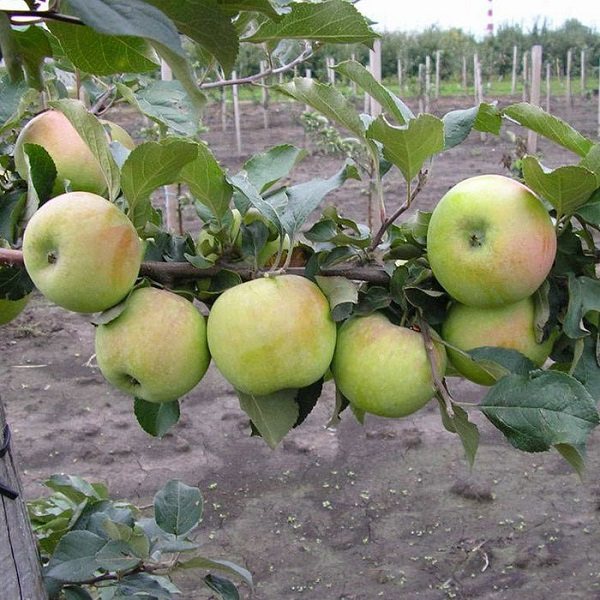

North synap on a semi-dwarf rootstock.
Dwarf
Blooms in the second year after planting. it miniature tree 2.5-3 m in height bears large (120-140 g) fruits, but lives only 25-30 years... The best dwarf rootstock of the North Sinapa is considered to be No. 62-396.
In the video below you can see what the North Synap looks like on a dwarf rootstock:
Attention! Dwarf apple trees have a shallow root system. They put up better with high groundwater. It is important not to deeply loosen their near-stem circle and tie a young tree to 3 pegs at once!
Harvesting and storage
In order for the apples to ripen, they need to stay on the branches for some time, so do not rush to harvest if you see that the blush has not yet appeared on the fruits.
Fruit keeping quality is good. Refrigerated storage at 0 to 1 ° C is possible until May - early June.
I got the Sinap along with the plot, I myself would not have planted such a high grade. It is already over 4 meters high and continues to grow. The crown is of medium density and spreading, the tree occupies an impressive part of the garden. It gives a lot of fruits, in summer all the branches are covered with small green apples, and by the time of harvest, they become medium-sized, 150 grams each, and change color to yellow-green.I pick it late, already in October, it is better not to rush with this matter: once it was rainy autumn, I was afraid that the apples would disappear, and took it off in mid-October. I hurried, the apples turned out sour and quickly went bad. And if you shoot on time, then they can lie all winter and spring until May. The harvest is always abundant without rest breaks, but only if you take care of the tree. In the spring, even before the ovary, I do pruning to thin out the crown, later I can cut off some of the shoots. Years of high yields are not good for the tree, the apples will turn out to be small and sour. During the active period, you need to constantly feed, water often, treat diseases and pests, paint the trunk. In gratitude for the care, the apple tree brings up to 40 kg of delicious apples every year, which can be stored for six months.
If anyone thinks that there are varieties of apple trees that do not need care, they are greatly mistaken. No matter how unpretentious the apple tree is, you still need, albeit small, but care. The Sinap North apple tree is considered an undemanding crop. However, from my own experience, I was convinced that you can't get apples without leaving. The tree itself is pretty attractive. It blooms with pinkish flowers, the branches branch off from the main trunk, forming a tent. So they must be cut off in the spring - shortened, and dry and diseased branches that interfere with the branches must be mercilessly removed. From this, the apple tree only bears better! Cover all sections with garden pitch. Be sure to feed the apple tree with fertilizers during the summer. We make shallow pits and pour a certain amount into it, and then fill it with water. We cover the trunk circle with rotted manure. Then the apple tree grows strong, resists pests. I also spray against pests with something harmless - Actor, for example. Whitewashing is required, fighting ants on the site. There are a lot of apples on the branches - I put slingshots so that the branches do not break off. The apples themselves are cups, ripen in September-October. Then they can lie for six months or more. The taste is excellent!
For five years, the tree grew almost as tall as a two-story house, and had to be stopped urgently. If you do not do this, they say, it will grow in height and width to incredible values. And then the quality of the fruits will deteriorate - the more there are, the smaller they are. Therefore, too fruitful years are not encouraging, but the average harvest is quite. Although there are fewer apples, they are larger and juicier. And if the fruits are too small, then for some reason they are tasteless, only the aroma indicates that it is an apple, not papier-mâché. The fruits of this variety are very interesting: oval, small, hard, like pebbles. I also call them chameleons. When I put them in storage, they are green, with a slight golden hue. But over time they turn yellow, a brownish blush appears on the "cheeks", and the skin becomes like oiled. The flesh of large apples is white, small ones are greenish.
A good variety for those who like to eat an apple in winter or spring, during the period of vitamin deficiency. Fruits ripen very late, almost by mid-October. Previously, it makes no sense to shoot - they ripen indoors, they are reluctant, But they are stored for a very long time - until May-June, they are free, and once I kept them even until August. And nothing happened to them - they did not dry out, did not rot. But, like all winter varieties, "Sinap Severny" has specific properties. Firstly, the fruits are quite small, one hundred to one hundred and twenty grams, very hard and not as juicy as late summer and autumn varieties. Secondly, the taste is muted, there are no bright sweet or sour notes, as for me, even bland. So they are not very suitable for jam-compotes. Although the rest of my household like them even more juicy varieties. It is also annoying that the trees grow very tall and spreading, and you need to cut it often, you are tortured to climb up. And if you do not cut it, the harvest will be completely useless.
Other types of Sinap
Orlovsky
The closest relative of the North. It also winter-hardy and moderately resistant to disease.
Differences between the Oryol Sinap and the North:
- Larger fruits (140-170 gr);
- Ripening 1-2 weeks earlier than the North;
- Sensitivity to calcium content in soil;
- Less sugar in apple pulp;
- Lack of frequency of fruiting in adulthood.
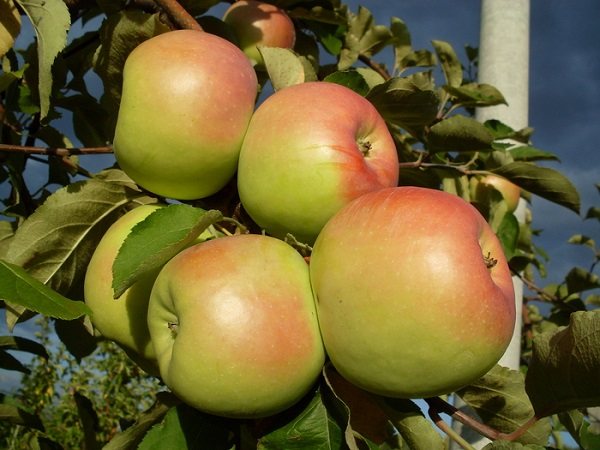

Oryol Sinap.
Qandil
Refers to heat-loving apple trees... The main value of the variety is yield, keeping quality and excellent taste of fruits... Disadvantages - "capriciousness" of the tree, late entry into fruiting and the frequency of harvests even in young plants.
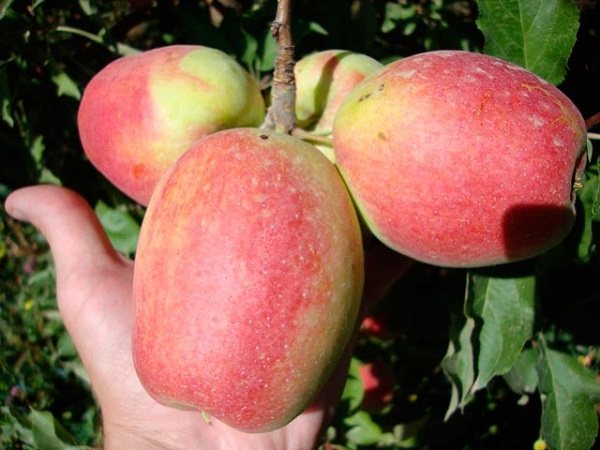

Sinap Qandil.
Belorussian
Less popular due to mediocre taste of apples and their low juiciness.
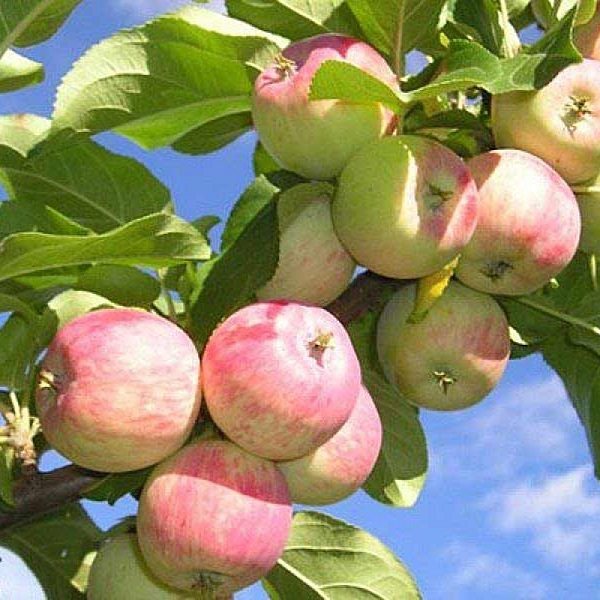

Belarusian synap.
Mountain
Refers to new varieties. It is included in the State Register for the North-West Region in 2009. fast growth, good taste and large fruit size, winter hardiness.
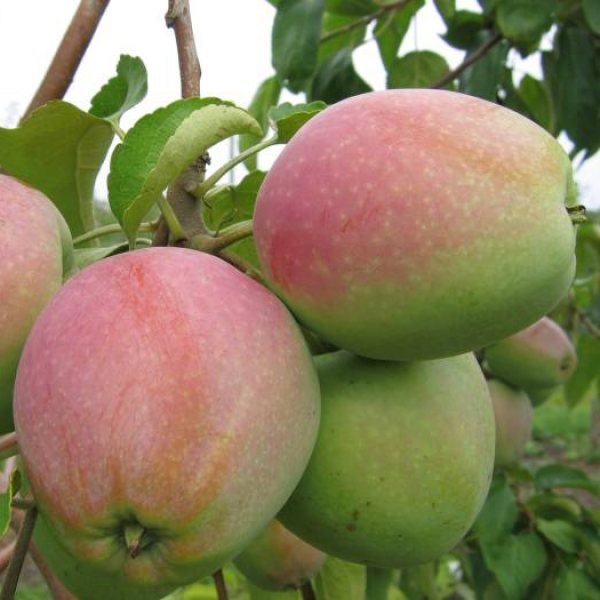

Mountain synap.
Watch the video review of the Mountain Sinap:
Minusinsky
Recommended for growing in East Siberian region... The tree gives small apples about 40 grams in weight, juicy, slightly sour taste.
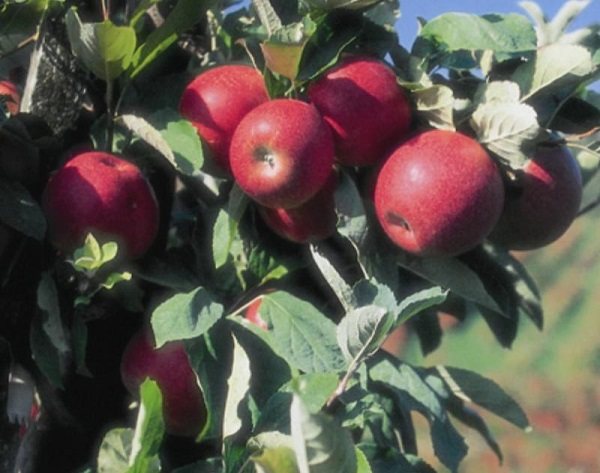

Minusinsk Sinap.
Khakass
A relatively new variety winter ripening periodrecommended for growing in East Siberian region.
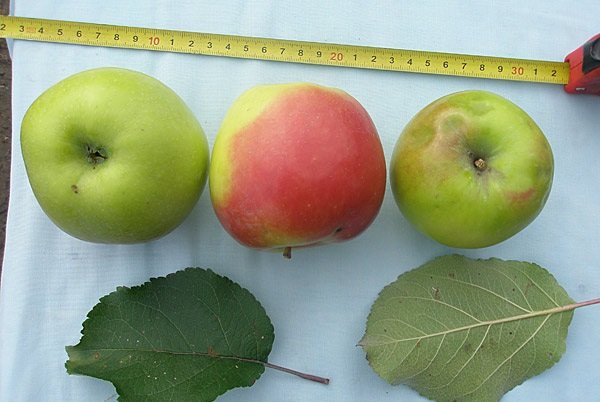

Khakass synap.
You can also watch a review of the Khakassian Sinap variety in the video below:
The history of breeding apple varieties
The appearance of the "Northern Sinap" was due to the desire of breeders to create something like the famous elite apple variety "Crimean Sinap", the fruits of which were brought specifically for the pre-revolutionary beau monde. The apples tasted excellent, but the costly and lengthy transportation caused resentment. Therefore, the staff of the Michurin All-Union Research Institute of Horticulture volunteered to create something new and necessarily with a frost resistance gene.
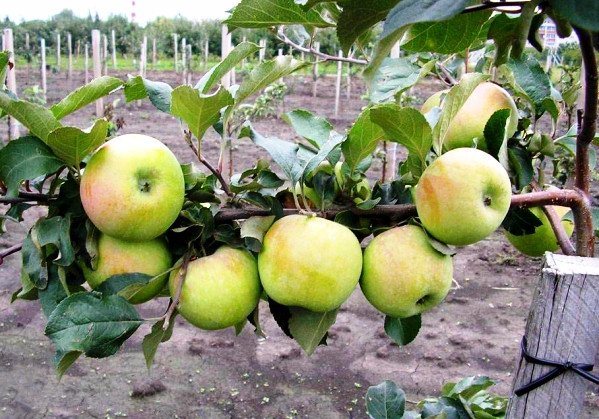

As a result of lengthy trials and experiments, a student and follower of Michurin, Sergei Isaev, produced the North Sinap variety. It was obtained by free pollination of the seed of the "Kitayka Kandil" apple tree and perfectly combined the highest taste qualities with endurance to harsh weather conditions. The author dreamed of such a tandem.
Later, the variety was zoned for other regions, taking into account the peculiarities of the climate and soil. Therefore, today such trees can be found both in personal plots and in the gardens of processing enterprises in Russia. In addition, the genes of the "Northern Synap" are fundamental in the following varieties - "Orlovsky Sinap", "Moscow Winter", "Moscow Later". The variety is recommended for breeders for use in breeding early ripening apple trees.
Growing in cold regions of Russia
The Sinap apple tree belongs to the winter-hardy varieties, respectively, in the Moscow region and in the Urals, it is not necessary to cover young trees for the winter. They are calmly tolerate frostthat are in these regions. Only in the most severe winters with temperatures dropping to 37-40 ° Ϲ is it possible for young shoots to freeze and slightly damage the trunk.
In Siberia and Altai Territory, freezing of young shoots is more possible. For planting seedlings, it is extremely important to choose a place protected from cold northerly winds... Until the young apple tree gains proper strength, it is recommended to cover it for the winter for the first 2-3 years after planting.
The apples of the Northern Sinap, grown north of Tambov, do not gain the proper sugar content and are inferior in taste to more southern fruits. For a more successful overwintering in the fall, you can feed the seedlings with phosphorus-potassium fertilizers.
Advice! If in the fall a young tree does not want to “go into winter”, keeping young green leaves on itself, it is worth cutting them off! The tree will "understand" that a cold snap has come, and its shoots will most likely go through the ripening stage. And young foliage only delays this process, drawing off nutrients.
Landing features
Before planting a plant, it is important to carefully study all the features of this process. Planting any seedling includes the following steps:
- careful examination of the seedling for the possible presence of rot, dry areas and mechanical damage on the rhizomes, as well as the presence of dry shoots. If you find characteristic brown edges on the roots, it is important to cut them down to living wood;
- treat the root system with a special talker;
- planting is carried out in a pre-prepared hole, straightening of rhizomes (in this case, the support should be on the south side of the seedling trunk in order to protect the culture from direct sunlight);
- watering the plant (if planting is carried out in spring, then water is poured until the soil stops absorbing moisture);
- dusting of rhizomes is carried out with a special substrate from the top layer of the soil (the trunk must be shaken several times so that all the voids that have arisen in the soil are quickly filled and the rhizomes do not have time to dry);
- a thorough examination of the root collar of the plant is carried out. It should rise five centimeters from the ground. Deepening such a place can lead to a deterioration in yield, and strong elevation leads to dehydration of the seedling and its imminent death. It is best to pour a small amount of earth on the root transition so that excess liquid can drain off during watering;
- mulching the trunk circle. In this case, fifteen centimeters retreat from the seedling in order to reduce the chance of being damaged by harmful bacteria that may arise during the decomposition of mulch;
- garter branches to the created support (for this, it would be best to use a fabric tape).
With poor care, the crop will develop poorly and lose a high yield.
In this case, it is important to pay attention to the timely watering of the plant, fertilizing, loosening the soil, mulching the trunks, protecting against diseases, dangerous parasites and rodents.
Where can I buy seedlings?
The best seedling will be the one grown in a similar climatic zone, preferably in the same region as the future place of growth. There are many options for purchasing seedlings. It can be:
- Exhibitions and sales of plants;
- Internet shops with postal delivery;
- Private household plots;
- Official nurseries.
Preference should be given to the latter: the risk of getting low-quality planting material and mistakes in the variety are practically excluded! Moreover, it is in official breeding stations and nurseries you can find out about the true disadvantages and advantages of the variety, and the peculiarities of growing in the area.
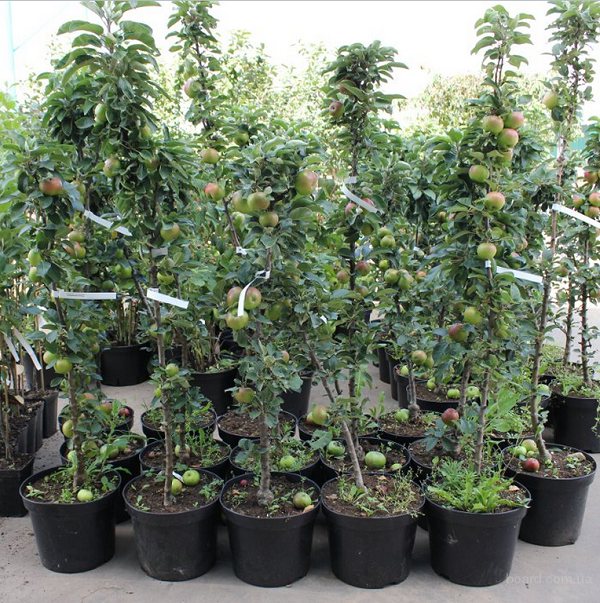

Saplings are best purchased from official nurseries.
Many private breeders and official organizations send seedlings by mail. But no seller can guarantee that the seedling will not be damaged on the way or dry out.
The advantage of plant sales exhibitions is a huge selection of different varieties and seedlings. When buying apple trees, it is important to make sure that the seller did not grow them in warmer regions than your area. "Southern" trees do not adapt well to frost and can die in the first 2-3 winters.
Useful Tips
- Pruning branches and shaping the crown is best done in early springthan late autumn! And all the cuts must be covered with garden pitch;
- Seedlings covered for the winter should be opened at an average daily temperature of about 0 ° Ϲ... With the onset of warm weather, unopened seedlings can support;
- The young bark of apple trees is very love hares and mice! The best defense against them is wrap a tree trunk with a nylon stocking or unnecessary rags... You can install a net near the stem. It is important that the shelter starts at ground level and has a height of at least a meter.

